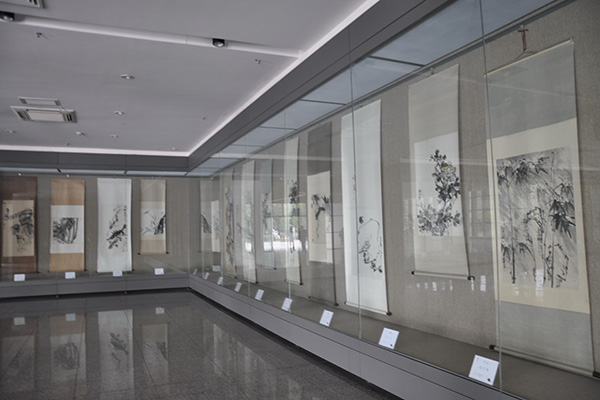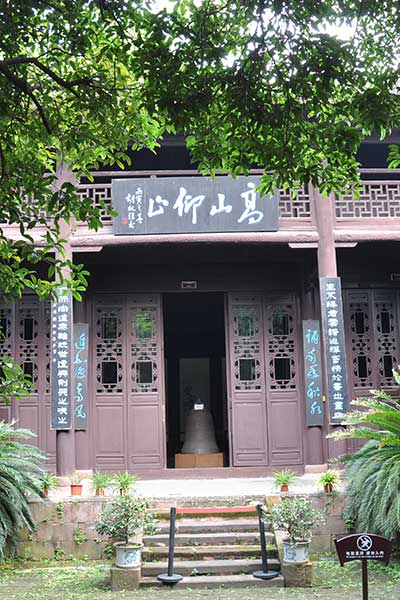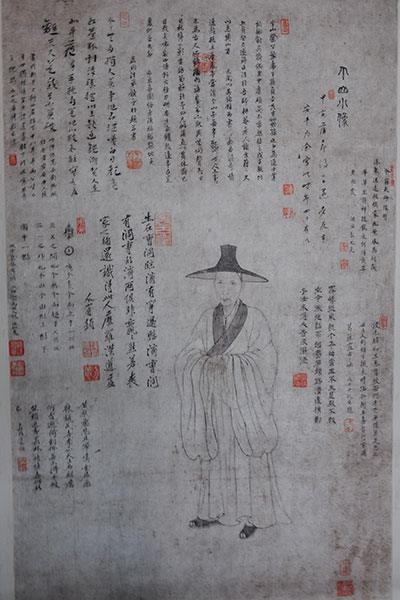
The Bada Shanren Memorial Museum in suburban Nanchang in Jiangxi province houses a rich collection of the legendary painter’s works and a portrait of the artist, painted by a good friend. [Photo by Shi Xiaofeng / China Daily]
A descendant of the Ming imperial clan who first became a Buddhist monk and then a Taoist priest, Bada Shanren represents both an intriguing life story and a unique art style that inspired generations of artists who followed him.
Visiting the place where he once dwelled as a Taoist priest, we are able both to find some clues of the master painter’s vicissitudes in life and appreciate some of his best art.
The Bada Shanren Memorial Museum sits quietly in suburban Nanchang in Jiangxi province. The site is tranquil in a natural setting, including a lotus pond, plenty of ancient trees and bamboo groves.

[Photo by Shi Xiaofeng / China Daily]
Adapted from a former Taoist temple called Qingyunpu and opened in 1959, the museum was the first one in China to be dedicated solely to an ancient painter.
The temple has basically maintained its look since the late Qing Dynasty (1644-1911). Its symmetrical layout features three main halls, which are connected by quiet corridors.
Some of the horizontal inscribed boards and couplets within are in Bada Shanren’s calligraphy style. In the halls, some copied works of Bada Shanren and his younger brother are displayed, too.
Meanwhile, more than 100 pieces of Bada Shanren’s calligraphy are delicately carved on stones along the corridors.
An enlarged copy of Bada Shanren’s portrait, painted by a good friend and clearly cherished by him with many of his inscriptions, is the most eye-catching item for us.

[Photo by Shi Xiaofeng / China Daily]
Looking at the thin face of the old man wearing a bamboo hat, we start to imagine how Bada Shanren lived for years and created a large number of works after he arrived.
Bada Shanren, whose original name was Zhu Da, was a member of the royal clan of the Ming Dynasty (1368-1644). However, his family split in his youth when the empire was overturned by the Qing Dynasty.
Saddened by that but impelled to survive, he became a Buddhist monk and later a Taoist priest, and made a living by selling his paintings. He remained a loyal adherent to the ousted dynasty and a dissident in the Qing Dynasty all his life. He never used his real name and intentionally hid from crowds and sometimes even pretended to be a madman or mute.
Bada Shanren’s art is closely connected with his life experiences. His paintings’ precise but expressive brushwork often employs symbolic images, such as fish and birds that appear supercilious with their eyes looking up, to demonstrate his unyielding and proud personality, and his hatred of the new ruler.
His art is greatly admired in the East, especially in Japan, and has enormous global influence as well. Many of his works are collected by museums around the world. In recent years, there have been examples of his works selling for tens of millions of yuan in auctions.
The museum has a rich collection of Bada Shanren’s works. Ten exhibition halls in a modern building to the temple’s north are used to display more than 80 of his original paintings and historical records about him.
Among them, there are many famous and representative pieces by him, such as Ink Lotus Flowers, The Bird and Stone, and Pine Tree and Cranes.
A visit here is a rare chance to see so many of the master’s works at one time.
After appreciating the art in the exhibition halls, visiting the memorial monument and statue of Bada Shanren in the museum to pay our respects seemed a perfect way to say goodbye to the great master and the museum.
